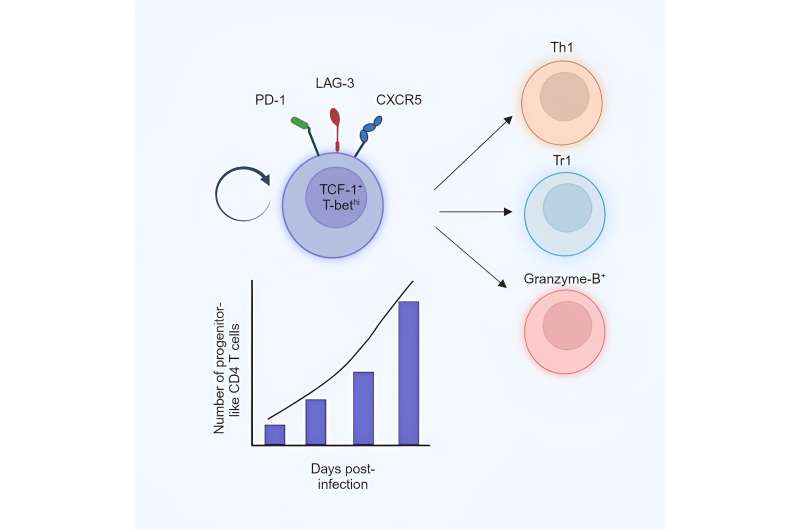This article has been reviewed according to Science X's editorial process and policies. Editors have highlighted the following attributes while ensuring the content's credibility:
fact-checked
peer-reviewed publication
trusted source
proofread
Hope for a cure for visceral leishmaniasis, an often fatal infectious disease

A discovery by Simona Stäger's team could help come up with a treatment for the most serious form of leishmaniasis. Leishmaniasis is a tropical disease affecting a growing number of people worldwide. Each year, between 700,000 and 1 million new cases are reported. Caused by a protozoan parasite of the genus Leishmania, which is transmitted to humans by the simple bite of a sand fly, leishmaniasis comprises three clinical forms, of which the visceral form is the most serious.
If left untreated, visceral leishmaniasis, also known as black fever, is almost always fatal. Most cases occur in Bangladesh, Brazil, Ethiopia, India, Nepal, and Sudan.
Professor Stäger of the Institut national de la recherche scientifique (INRS) and her team, in collaboration with other researchers from INRS and McGill University, have observed a surprising immune mechanism linked to chronic visceral leishmaniasis. This discovery could be an important step towards a new therapeutic approach to this disease. The results of their research have been published in the journal Cell Reports.
In many infections, CD4 T cells play a key role in defending the affected organism. Unfortunately, in the case of chronic infections such as leishmaniasis, maintaining the number of functional CD4 cells becomes an important issue, as the immune system is constantly activated to react against the pathogen affecting the infected person.
New immunity soldiers to the rescue
However, the study carried out by Professor Stäger in her laboratory at INRS's Armand-Frappier Santé Biotechnologie Research Centre suggests that these cells may have more than one trick up their sleeve to maintain their vitality.
"We have discovered a new CD4 cell population in mice infected with the parasite responsible for visceral leishmaniasis. These T cells have interesting properties," said Professor Stäger.
By observing these novel cells, the scientists noticed that they increase in number during the chronic phase of the disease and also that, like progenitor cells, they are capable of self-renewal or differentiation into other effector cells responsible for eliminating the parasite, or regulatory cells that inhibit the host's response.
Professor Stäger points out that CD4 T cells normally differentiate into effector cells from "naive" CD4 T cells. But during chronic infections, because of the constant need to generate effector cells, naive CD4 T cells are highly solicited and may become exhausted.
"We believe that in the chronic phase of visceral leishmaniasis, the new population we have identified is responsible for generating effector and regulatory cells. This would allow the host to prevent exhaustion of its existing pool of naive CD4 Tcells for a certain antigen," explains Ph.D. student and first author of the study, Sharada Swaminathan.
The new lymphocyte population discovered by the INRS team could be a decisive immune booster, taking over from over-solicited naive CD4 T cells.
"If we can figure out how to direct this new lymphocyte population to differentiate into a protective effector cell, it could help the host get rid of the Leishmania parasite," said Professor Stäger.
A cure for other infections?
The study also mentions that cells similar to this new CD4 T lymphocyte population have been observed in mice infected with lymphocytic choriomeningitis virus and in mice carrying the H. polygyrus intestinal worm. So it is quite possible that this population is present in other chronic infections or in other chronic inflammatory environments.
This overlap sets the stage for an even wider scope for the discovery made by Professor Stäger's team. "If our hypothesis is correct, these cells could be exploited therapeutically not only for visceral leishmaniasis, but also for other chronic infections," concludes the researcher.
This article was co-authored by Sharada Swaminathan, Linh Thuy Mai, Alexandre P. Meli, Liseth Carmona-Pérez, Tania Charpentier, Alain Lamarre, Irah L. King, and Stäger.
More information: Sharada Swaminathan et al, LAG-3- and CXCR5-expressing CD4 T cells display progenitor-like properties during chronic visceral leishmaniasis, Cell Reports (2024). DOI: 10.1016/j.celrep.2024.113879


















